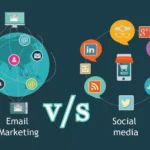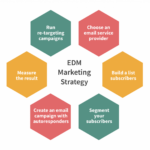Every tool is accompanied by guidelines to help users understand the best way to operate it to avoid misapplication as well as to resolve a problem. A tool as powerful as drip marketing is no exception.
What is Drip Marketing?
Drip marketing, with its automated emails triggered by customer (in)activity, is a versatile way for businesses to capture and retain the attention of their prospective, inactive, and returning customers.
Properly utilizing drip marketing can lead to enhanced customer experience in addition to increased brand relevance, while a misapplication of this strategy can produce customer dissatisfaction, reduced brand visibility, reduced conversion, etc. Therefore, every business needs to understand how to harness this powerful strategy for a successful email marketing campaign.
To help you easily recall, I have put these best practices into categories that should be considered.
1. Email Type:
The type of emails you send affects your conversion rate for every drip marketing campaign. To maximize your drip marketing efforts, create,
a. Personalized and targeted emails:
Personalized and targeted emails are emails that are tailored to suit the individual recipient’s needs, preferences, and behavior. By utilizing data such as their name, previous interactions, purchase history, or demographics, businesses can deliver content that is highly relevant to each recipient.
When emails resonate with recipients, they are more likely to open, read, and engage with them. They also have a significant impact on conversion rates. When emails are customized to address specific customer needs and preferences, they are more likely to inspire action.
b. Time-conscious emails:
Statistics show that timing is everything. Email send times affect your open rates. Brevo’s analysis shows that the overall best day to send an email is Tuesday or Thursday, and the overall best time is 10:00 a.m. or 3:00 p.m. However, it is important to take into account the type of audience you attract with your drip marketing campaign. For example, 9-to-5 workers are more likely to check their inboxes early in the morning before or during work. Therefore, if your business’s target audience is white-collar workers, 4:00 a.m. to 9:00 a.m. is an ideal timeframe to send your drip emails.
c. Emails for triggers and notable events:
Drip marketing is a trigger-induced marketing strategy, so it makes sense to maximize its potential by setting up triggers for most events. Set up welcome emails for new subscribers, purchase receipt emails, onboarding emails, product recommendations, subscription renewal reminders, product purchase reminders, etc.
Doing this keeps your brand’s products and services top of mind for your subscribers. Triggers can even be set up for when a subscriber clicks the unsubscribe button. You can use this to gather data on why your subscribers choose to unsubscribe, explain how their patronage will be missed, and inform them they’re welcome to re-subscribe at any time.
Emails should also be set up for events like birthdays, celebrations of their anniversary with you, holidays or religious activities they observe, etc. Showing your customers you care and remembering important things about them will induce loyalty to and advocacy for your brand.
Note: You should always set up time-sensitive emails like purchase order receipts to be delivered promptly.
2. Email Volume:
Having a cluttered inbox is the most aggravating thing for almost everyone. Users do not want an inbox saturated with unopened emails, no matter how relevant they may be. So, to ensure that your drip marketing strategy produces positive results,
a. Limit your emailing frequency:
Curb the urge to litter your subscribers’ inboxes with multiple drip emails to avoid them associating your brand with negative emotions. Overmailing can lead to decreased open rates and increased unsubscribe rates and can cause subscribers (or even the mailbox) to flag your emails as spam.
Undermailing can also cause you to miss out on sales opportunities and reduce brand recognition, so experts recommend that 2-3 drip emails a week is a satisfactory amount to keep your brand top of mind, engage customers, and avoid customer dissatisfaction.
3. Email Content:
From the subject line to the signature, the content of your email plays a crucial role in grabbing your subscriber’s attention and driving conversion. Therefore,
a. Craft an eye-catching subject line:
The first thing your subscriber sees after the sender’s name is the subject of the email. It’s the hook for every subscriber. You should craft personalized hooks that inform them of opportunities, funny hooks to grab their attention, and ones that pique the curiosity of the subscriber. Make sure that the subject line informs the subscriber what the message of the email is.
b. Create engaging copy:
Make your email stand out in the subscriber’s mind by creating a concise and comprehensive copy. If it’s not an email replying to their complaint, most subscribers skim the message in your email. To keep them engaged, make the copy brief and easy to read, and add links to direct them to where they can get more information if it’s something that interests them.
c. Include a call-to-action:
A call-to-action nudges the subscriber to take the next step you would like them to take. Always include a CTA to tell them what to do next. It can be a link to a website or a white paper they can download.
“You should always set up time-sensitive emails like purchase order receipts to be delivered promptly.”
– MailDrip
4. Email Service Provider:
a. Select a relevant ESP:
Different ESPs offer different features, so you must select the ESP or email marketing platform relevant to your business needs and drip campaign. For example, MailDrip specializes in automated drip emails and provides businesses with features to execute a successful drip marketing campaign.
They also present a pricing plan that accommodates businesses at whatever scale they are. Your chosen email marketing platform can make or break your drip campaign, so it is always recommended to make informed choices.
5. Email Metrics:
Data culled from your drip campaign should be the number one influence on your campaign. A data-driven approach to your drip campaign will help you deliver to your subscribers what they want while contributing to your business’ growth.
a. Monitor campaign reports:
Watch and analyze the statistics presented for your drip campaign. Drip campaign analytics give you information on the performance of your campaign and should be regularly monitored. These metrics should inform your decision on the next move to make in your campaign.
For example, If your subscribers are more receptive to your emails at certain times of the day, then arrange your emails according to an order of importance and focus on sending the relatively important ones at those times.
b. Carry out tests:
A better way to understand customer behavior and likes is to carry out experiments in your campaign. Implement A/B tests to understand what drip email design, copy, and CTA your subscribers respond better to.
You can segment your subscribers into a control and experimental group and send them two emails with similar content but different subject lines to test which subject line performs better. Then, use the winning subject line in your email and continue testing other factors.
6. Subscriber Metrics:
a. Segment your subscriber list:
Dividing your subscriber list will allow you to send drip emails that are tailored and relevant to each individual. You should segment based on demographics, behavior, pain points, etc. You can get this information through the sign-up form on your website or by sending a survey to all your subscribers.
b. Plan around the customer’s journey:
Different subscribers are at different stages of the customer journey, so it is important to plan a drip campaign for every stage. A subscriber in the consideration stage of the customer journey requires a different type of email to drive conversion than a subscriber who just became aware of your brand.
Your drip campaign should have different touchpoints in place for every type of subscriber before making your offer available.
In summary:
Conclusion
Executing a drip campaign with these practices while consistently bringing value to your customers will deliver an improved customer experience and ensure your business goals are met.
- Beginner to Boss: Mastering Email Marketing (Without Breaking the Bank)
 by Ojukwu SheilaTo succeed in the field of email marketing, one must first establish a solid foundation based on fundamental ideas and tactics. This section provides the foundation for our trip, outlining the essential ideas that any prospective email marketer needs to comprehend.
by Ojukwu SheilaTo succeed in the field of email marketing, one must first establish a solid foundation based on fundamental ideas and tactics. This section provides the foundation for our trip, outlining the essential ideas that any prospective email marketer needs to comprehend. - Reach vs. Nurture: How Digital & Email Marketing Work Together
 by Ojukwu SheilaDigital marketing refers to the use of the Internet and digital communications to promote a brand or business. It encompasses a wide range of strategies, which include:
by Ojukwu SheilaDigital marketing refers to the use of the Internet and digital communications to promote a brand or business. It encompasses a wide range of strategies, which include: - Segment, Personalize, Win: The EDM Equation for Email Mastery
 by Ojukwu SheilaUsing personalization effectively is essential to mastering email marketing with EDMs. Email marketers may create dynamic content by using Maildrip, which lets them change the content of emails based on recipient information. With features like purchase recommendations and personalised welcomes, Maildrip ensures that every EDM is specifically tailored for the receiver, increasing engagement.
by Ojukwu SheilaUsing personalization effectively is essential to mastering email marketing with EDMs. Email marketers may create dynamic content by using Maildrip, which lets them change the content of emails based on recipient information. With features like purchase recommendations and personalised welcomes, Maildrip ensures that every EDM is specifically tailored for the receiver, increasing engagement. - 15 Types of Email You Should Not Be Sending
 by Ojukwu SheilaAn overly sales email tends to prioritize pushing products or services over building a meaningful relationship with the audience. Instead of bombarding subscribers with relentless sales pitches, focus on establishing trust and providing value. Share insightful content, industry knowledge, or exclusive offers to engage your audience genuinely.
by Ojukwu SheilaAn overly sales email tends to prioritize pushing products or services over building a meaningful relationship with the audience. Instead of bombarding subscribers with relentless sales pitches, focus on establishing trust and providing value. Share insightful content, industry knowledge, or exclusive offers to engage your audience genuinely. - Beyond the Basics: Discover the Secret Weapon of High-Converting Drip Campaigns.
 by Oluebube AnukamAre your email sequences stuck on autopilot? Feeling a little “set it and forget it” when it comes to your email marketing? It’s time to take the wheel! MailDrip Mastery unlocks the power of advanced email automation, transforming your campaigns from basic blasts to finely tuned customer journeys.
by Oluebube AnukamAre your email sequences stuck on autopilot? Feeling a little “set it and forget it” when it comes to your email marketing? It’s time to take the wheel! MailDrip Mastery unlocks the power of advanced email automation, transforming your campaigns from basic blasts to finely tuned customer journeys.





